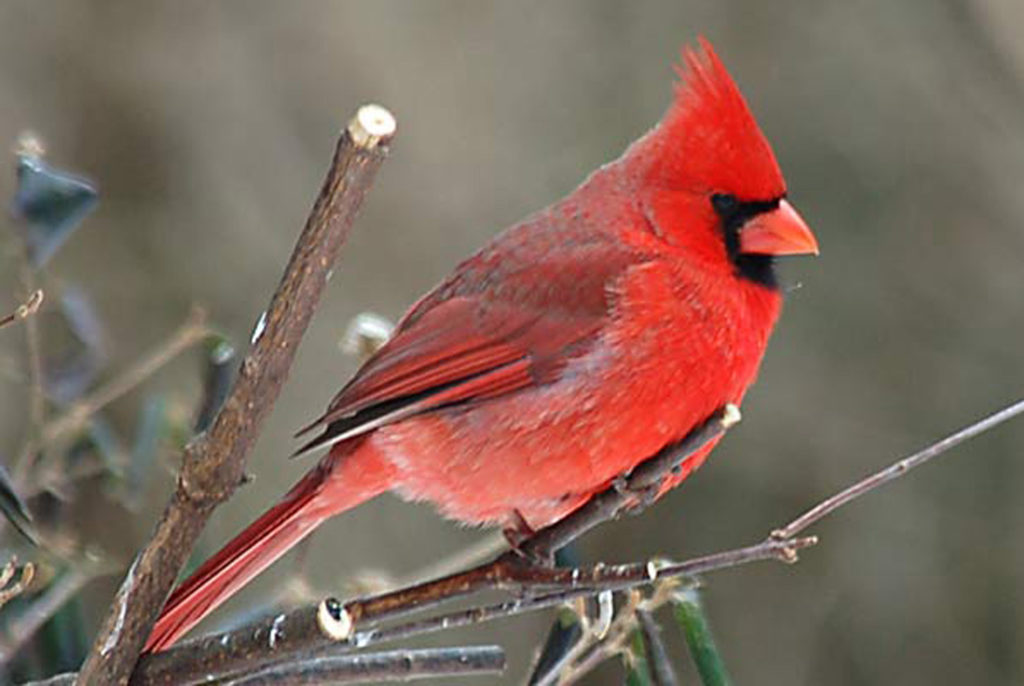The nice thing about February 15, perhaps even more so than Groundhog Day (Feb 2nd) is that spring feels a lot closer. Oh, we may get a few cold spells still, and no doubt more snow, but the sun is brighter and already it’s noticeable that it lingers longer in its sweep across the heavens – up earlier in the morning and still light after 5 o’clock.
And Love is in the Air.
February 14 is Valentine’s Day, that curiously celebrated day for romantic love, when the rituals of courting begin, or reset. We think of Spring as the time for awakening love interest, so why St. Valentine’s Day in mid-February, surely two months short of Spring Fever?
Love is in the Air. If you’re an ornithologist, as I am, you’ll know that Northern Cardinals are amongst the earliest of birds beginning the mating season. The brilliant red males warn rivals with their territorial calls in February, and hoping for a female to proffer her favours. Shy females flit unnoticed from branch to branch, apparently unmoved by the feverish male’s display. Cardinals allegedly mate for life but you wonder if one of those flighty females abandon her old partner for the attention of some new, brighter, stronger, songster.

Love is in the Air. Do you remember that song from 1977, by Australian John Paul Young? Or maybe it was the Martin Stevens (Canadian) version? No? Me neither, except for the catchy disco tune, and the catchier phrasing. I was a 60’s teenager with hormones in overdrive, but by 1977 I had turned 30, had an advancing career and two kids. I’m not sure love was in the air for me then, but Marlene evidently had other plans and by 1980 we had child number 3.
Today, as I look out my home-office window at the encouraging sun, I think about the wonder that was the promise of young love. We’re not conscious of it but the twin forces of biological drive coupled with the cultural meme of romance, have already captured the minds of mindless 15-year-olds increasingly aware of the opposite sex. We begin to peddle the meme, at least in North America, to kinds in Grade 1, or earlier: ‘Who’s your valentine?’. Kids pester their moms to buy a package of Valentine’s cards and write one out for every kid in the class, except for Johnny (nobody likes Johnny) and maybe the boy she’s actually sweet on but is too shy to show him. And the boys have it worse. 8-year-old boys are terrified of their female classmates and shrink in horror at the prospect of passing out valentine’s cards to those strange species. And the beginnings of fear of rejection are already stirring.
We add to this cultural meme by displaying romantic behaviour in front of our four-year-old kids, unintentionally, or perhaps with only the best of intentions. I remember one long ago Valentine’s Day buying a box of chocolates and a card for my wife Marlene, when eldest daughter Shannon was four, and, being a sensitive dad at the time, I bought chocolates and a card for her too. But the poignancy came the following year when, preoccupied with some career event or other, I forgot to bring home the goods. Marlene was very understanding, but the impressionable five-year-old took off to her bedroom in tears.
Is this what Saint Valentine meant to promote? I’m not sure eros was what he had in mind. More likely it was the Greek notion of philia – the love of family and close friends – or even more so the universal love of agape. Regardless, the poor man lost his head by command of Claudius II in 269 A.D., on February 14, apparently. It’s not clear when he was actually beatified, and there is confusion as to whether there was one, two or three such Valentini. Bishop Valentinus (of Tierni, and Rome?) allegedly married Christian couples so that men may escape conscription to the Roman army, and this surely upset Caesar more than Valentinus tending to persecuted Christians in the Coliseum. The account mentions that in order “to remind these men of their vows and God’s love, Saint Valentine is said to have cut hearts from parchment”, giving them to these newly-weds, a possible origin of the widespread use of hearts on St. Valentine’s Day.
Curiously, Valentine is not only associated with romantic love but is also the patron saint of epilepsy and beekeepers.
How is it that, in Western culture at least, even in these enlightened times of gender equality, Valentine’s Day is mostly about the man romancing the woman?? Does the man have to make all the effort to earn the affection of the woman? I think again of those fervent cardinals calling their little hearts out in the hope of getting laid.

(I should hasten to add, Valentine’s Day surely stirs the hearts of homosexual couples too, but is there yet a divide between the role of the suiter and the role of the sought?)
And what of all those people who no longer have interest, or capacity, for romantic love, or are widowed or involuntary celibates? Or separated from their love object by thousands of miles? Valentine’s Day for them is surely a bittersweet time, with only memory and yearning as companions.
And speaking of abstinence, the irony, this year, is that Valentine’s Day came on Ash Wednesday, the first day of Lent, when we forsake some pleasure or leisure or luxury item for six weeks. Ash Wednesday follows Shrove Tuesday (Pancake Tuesday in English-influenced countries, or Mardi Gras (Fat Tuesday!) in the Spanish world) the last chance to celebrate and indulge hedonistically before your period of penance. Maybe Valentine’s Day this year should have been celebrated on the 13th rather than the 14th, the loving couples taking themselves off to local diners to indulge in platters of pancakes and sausages, lathered in butter, dripping in maple syrup.

The purpose of Lent is the preparation of the believer for the salvation of Easter, resisting temptation through prayer, mortifying the flesh, repentance of sins, almsgiving, simple living, and self-denial. In Lent, many Christians commit to fasting, or abstinence, as well as giving up certain comforts, in imitation of Jesus Christ’s sacrifice during his journey into the desert for 40 days. I wonder how many Christians give up sex during Lent. Or last 40 days without?
Love is in the air. It is difficult to resist the temptation of Satan when he comes dressed in red feathers and calls from the trees.
Doug Jordan, reporting to you from Kanata, Canada
© Douglas Jordan & AFS Publishing. All rights reserved. No part of these blogs and newsletters may be reproduced without the express permission of the author and/or the publisher, except upon payment of a small royalty, 5¢.
